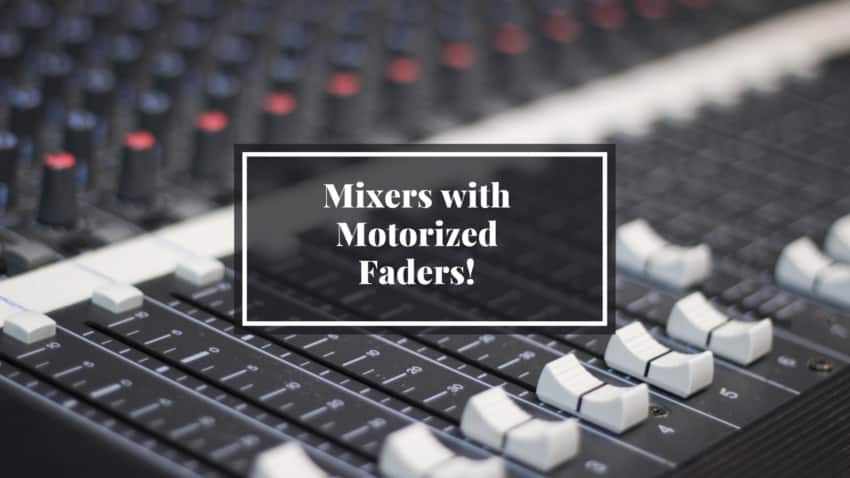Last updated on December 30th, 2023 at 02:56 pm
Mixers with motorized faders are great for recalling the settings of a previous session as well as giving you the option, in many cases, to use it as a control surface for your DAW for automation purposes, and more.
In this post I will list the top mixers currently available that will not only work for bigger studios, but small home studios as well that feature motorized faders, and I will also give you a quick explanation on why motorized faders are advantageous.
Note: All mixers that come with motorized faders are quite a bit more expensive than any other kind of mixer.
Let’s get to it!
Why use a Mixer in a Studio?
A mixer works in a very different way than an Audio Interface does, and it comes with some clear advantages that are great for studio recording.
Note: If you want to learn more about the differences between an Audio Interface and a Mixer, read this post I wrote.
Latency
One clear pro of a mixer is having no latency while recording. Let me explain;
If you want to record let’s say a vocal and listen back to it in real time on headphones, latency can be a problem.
Latency happens because the signal is being sent to the computer, processed and then back out again, and this takes time and ends up sounding like a slap-back delay.
A mixer was designed to do this instantly since it doesn’t need to send the audio to the PC first to let you hear it, and you can add effects to it, and more.
No Software Required
Yes, you will require a DAW to record your music, but that’s pretty much it.
The mixer will do everything else, from the headphone mixes, to adding effects to each headphone mix or even to any track that’s being recorded, and more.
Also, a mixer will work even if the computer isn’t even connected to it, and this can be useful when the band wants to play and hear themselves while not recording or without having a DAW session open.
Lastly, most modern mixers can record to an SD card, meaning that you could potentially ONLY use the mixer for everything.
Better Workflow
Mixers are “hands-on”, and if you only use an audio interface then you know that you will have to use the DAW to control everything, and this is done using the mouse.
With a mixer, especially the ones that have the option to be used as a control surface like the ones in this article, you can move the faders on the mixer to control the faders inside of the DAW.
The same goes for effects, etc.
It certainly feels more like playing an instrument and the mixing process becomes faster and way more enjoyable.
Streaming
While you can stream audio in multiple ways, if you don’t have a mixer you will need to rely on software… and software crashes, doesn’t work, and is always tricky to use.
With a mixer you can easily mix the multiple audio sources, get them to sound right and then simply send that to the computer for streaming.
Basically, it’s a much simpler and reliable way of doing things.
Why use Motorized Faders?
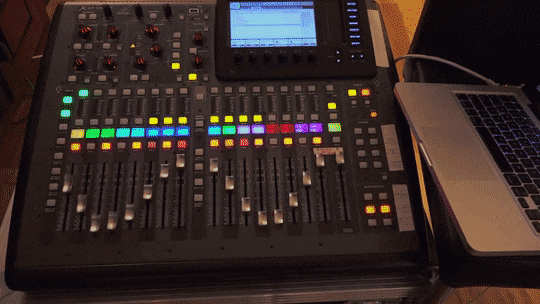
There are multiple reasons why having motorized/moving faders can be extremely beneficial, not just for studios but also for live performances.
Here are the two most important reasons;
Layers
In a digital system you can have multiple fader settings for different headphone mixes, or even use 10 faders to control 50 tracks, if you so desire.
You can set up a headphone mix for the control room and save that as a snapshot, then do the same for all the different headphone mixes.
If you want to change anything on those snapshots you can recall them with the press of a button and all the faders will jump to the position you had set them to.
This will let you create completely different headphone mixes for each musician, add specific effects to each track on that mix, and more.
Additionally, these mixers also allow you to control let’s say the first 12 tracks in your DAW with the 12 faders on the mixer.
However, if you want to use the same faders to control the next twelve tracks in the DAW, you usually just need to press one button and that’s it; now faders 1-12 will control tracks 13-25, etc.
DAW Control
I already mentioned this, but all of these mixers let you control most of what’s going on in the DAW directly from the board.
Not only does this mean that you won’t have to click around with your mouse to adjust everything, but more importantly, with the mouse you can only control one knob/fader at a time…
With a mixer, since you have two hands, you will be able to adjust two things simultaneously or play around by lowering the volume fader of a track while at the same time raising a specific EQ band, etc.
It just gives you more options in general.
Do Motorized Faders improve the DAW workflow?
While having motorized faders isn’t really necessary, it can improve your workflow for the reasons I mentioned earlier about having different layers and being able to control the DAW with it.
Some mixers, like the Presonus StudioLive ones, even let you add processing to the tracks directly on the mixer by loading plugins, etc., and once you move over to the DAW, which in this case has to be Presonus Studio One, with the press of a button the DAW will import all the settings of the plugins used on the mixer.
This means that you can mix literally everything on the board and then simply export the plugin settings to the DAW to adjust a couple details, but the mix itself will have happened completely on the board.
Now, without further ado, let’s take a look at the mixers.
Best Mixers with Motorized Faders
Presonus StudioLive Series III
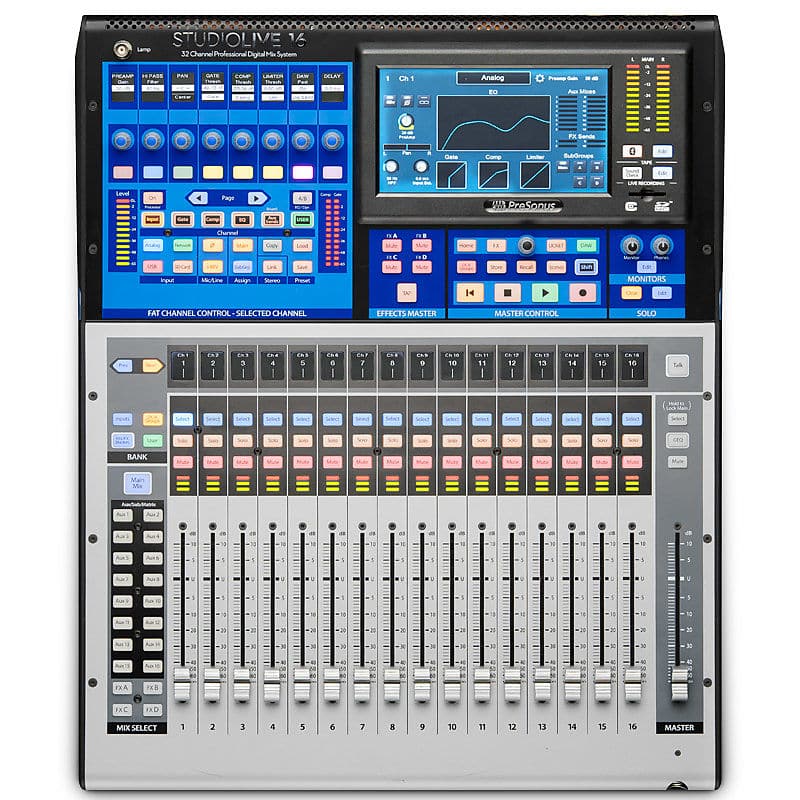
The StudioLive Series are the latest digital Presonus mixers and they range from 16 channels all the way up to 64.
These mixers are capable of multitrack recording and also feature the DAW control mode, which turns the mixers into a control surface for your DAW.
One feature of these mixers is the Fat channel, which is the section that delivers a compressor, limiter, gate/expander, and four-band parametric EQ on every input channel and the mix bus.
The Fat Channel features a touch screen and allows you to access different types of compressors, EQs, etc.
This gives you a lot of options and a simple and fast workflow, plus it also provides a highpass filter on every channel and aux bus and polarity invert for each input channel.
When recording, you can choose to record the audio with the effects you add to them or the RAW files, if you want to do all the processing in the box.
Motorized faders are also featured on these consoles and this is useful when linking two channels together and even for fader layering, creating different headphone mixes for every musician and recalling those with the press of a button, etc.
Lastly, with the purchase of a StudioLive mixer you get Studio One Artist included, and one interesting feature of using the mixer with the Studio One software is that you can import the settings of the plugins on the Fat Channel directly into the DAW with the click of a button.
This means that if you had a great-sounding mix going, you don’t have to start from scratch on the PC, just one click and all the settings will be moved over to the DAW.
You can get the Presonus StudioLive series III mixers here:
- StudioLive 16: Guitar Center.
- StudioLive 32: Amazon, Sweetwater, Guitar Center.
Behringer x32 Producer
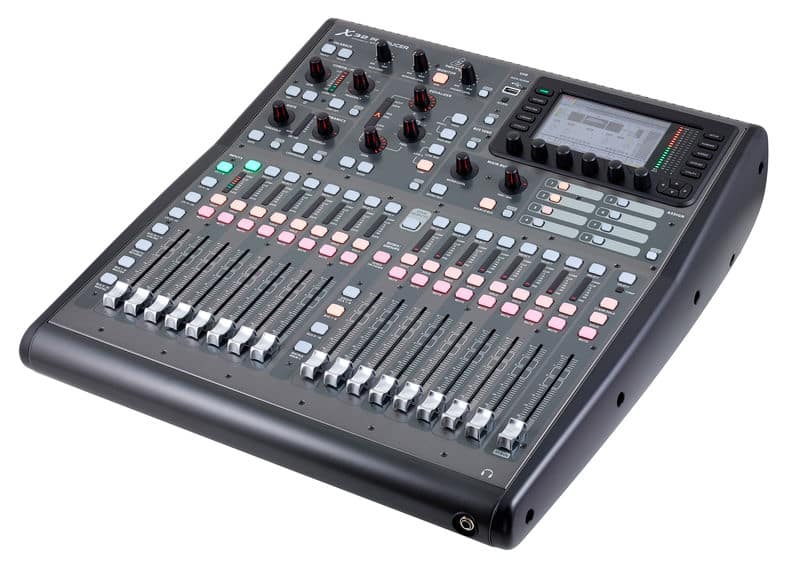
With the Behringer X32 Producer you will have the ability to multitrack a total of 32 tracks directly to your DAW.
If you need more inputs, you can use the expansion slot to get an additional 32×32 channels.
This mixer comes with motorized faders, which really comes in handy when switching between different banks of faders, since they will jump to the correct position, plus motorized faders are extremely cool!
Since it is a digital mixer, you get access to a hefty number of effects, a 31-band graphic EQ, as well as the ability to control it wirelessly or via Ethernet by using a dedicated app.
This can be useful to the engineer as well as the musicians, since they can control their own headphone mix from their wireless device directly from the stage.
One feature of the Behringer X32 Producer is the “Auto Mix” function, that enables automatic gain sharing, providing increased gain to your main speakers while ducking open mics.
Lastly, with the purchase of one of these mixers you also get a free Tracktion 4 download (Digital Audio Workstation).
Get the Behringer X32 Producer here: Amazon, Sweetwater.
Behringer Wing
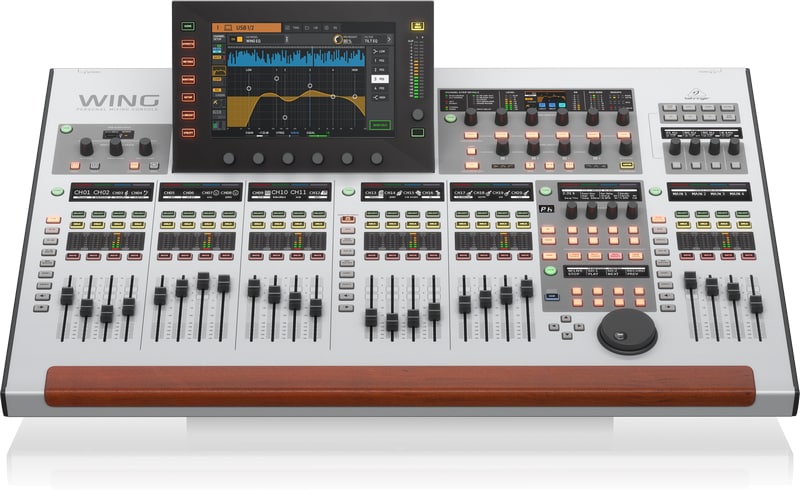
The Behringer Wing is a digital console that features 48 channels (mono, stereo or Mid/Side compatible), 16 buses, 8 matrix buses and 4 main buses.
Everything on this console is configurable; from the way the channels are laid out, to the routing of the signals and even the lighting of the console itself.
It features a touchscreen where you can monitor what is going on as well as access all the controls to configure literally everything.
The channel count can be increased to up to 144 by connecting stageboxes to the three AES50 ports, which is huge!
Just like the previous digital consoles on this list, the Behringer Wing can be accessed remotely via an App, giving you the ability to control everything directly from the stage as well as letting the musicians manage their own headphone mixes.
One feature that is unique to this console is the 32-channel StageCONNECT interface for personal monitoring or analog I/O boxes, which is ideal if you’re using external in-ear monitor transmitters, for example, since you can route them out using a single XLR cable into a breakout box.
Not only can you do multitrack recording to your DAW with this mixer, but also up to 64-track recordings on-to an SD card.
Lastly, it features 16 true-stereo processors with effects, High-Pass Filter, Tilt EQ and much more.
Get the Behringer Wing Mixer here: Amazon, Sweetwater, Guitar Center.
Allen & Heath Qu Series
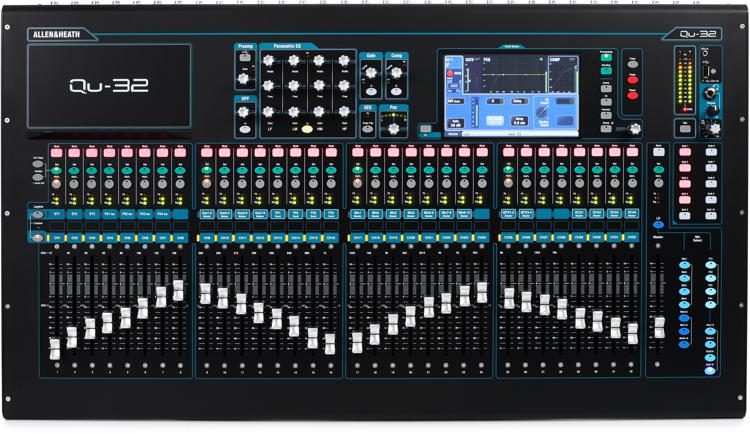
The Qu series mixers by Allen & Heath are feature-packed digital mixers that range from 16 channels all the way to 32 channels.
These mixers are plug-n-play on mac and also work perfectly on Windows once you install the driver.
They feature three different layers that will let you access the mono channels, the stereo channels as well as the fx sends/returns and fx masters, and your own custom layers.
The motorized faders will instantly move to show the current settings of those layers when you access them, giving you a quick overview of how those layers are set up.
The super strip controls let you adjust parameters such as panning, compression, Gate, etc. directly from the board itself, or you can also do this through the touchscreen, which also comes with a lot of added functionality;
The touchscreen can also be used to create track groups, mute those groups, change the routing options, and it even comes with a real-time analyzer of the frequency content of the mix.
Wireless remote control is also available, and this lets you walk around the venue while mixing the audio.
Get the Allen & Heath Qu Series here;
- Allen & Heath Qu 16: Amazon, Sweetwater, Guitar Center.
- Allen & Heath Qu 24: Amazon, Sweetwater, Guitar Center.
- Allen & Heath Qu 32: Amazon, Sweetwater, Guitar Center.
Yamaha TF Series
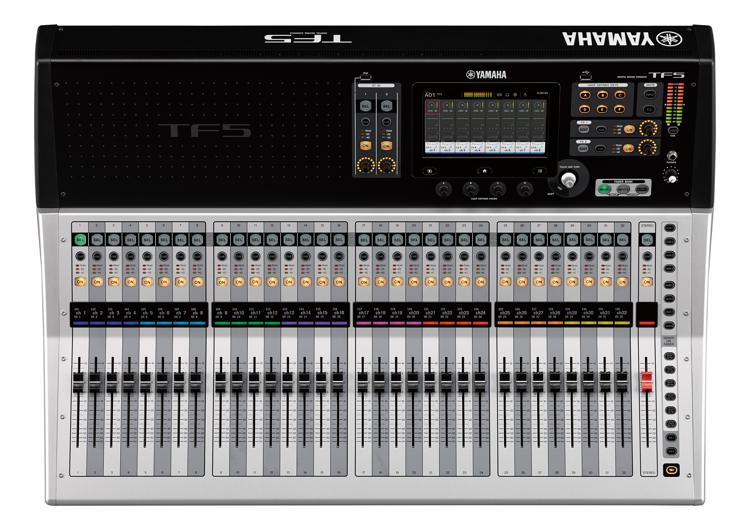
The TF Series by Yamaha are comprised of three different mixers; the TF1, TF3, and TF5 and they feature 16, 24 and 32 inputs and faders respectively.
The features on these are identical with the only difference being the overall channel count.
One interesting feature about these mixers is the footswitch input, that can be used to turn on and off effects, for tap-tempo delay, and more.
Wireless remote control is also available for these mixers, which lets you mix from an iPad or Tablet without the need of being near the board.
Like all digital mixers, the TF Series come with a touchscreen that gives you hands-on control of most of what’s going on inside of the mixer.
You can scroll through the different Fader Banks by pressing the buttons under the “Fader Bank” section, and this will let you go through custom layers, groups, and more, and when you press them, the faders will immediately jump to the position you had set them to for those layers.
Any parameter can be adjusted for any individual channel by pressing the “Select” button on the top of the channel to then add effects, adjust the panning, and more, directly from the screen.
One interesting thing about these mixers is that the guys at Yamaha came up with a lot of EQ presets for specific microphones that you can access, and these will already be tailored to get that specific microphone to sound as good as possible.
You can also dial in how accentuated that EQ curve should be, which is definitely interesting.
This is a nice feature to have, even though I don’t see it being THAT useful considering that the same EQ curve won’t apply to all vocalists/instruments the same way.
Get the Yamaha TF Series here;
- Yamaha TF1: Amazon, Sweetwater, Guitar Center.
- Yamaha TF3: Amazon, Sweetwater, Guitar Center.
- Yamaha TF5: Amazon, Sweetwater, Guitar Center.
And last but not least…
SSL Consoles

Now, the idea behind this article was to provide you with a list of the best consoles for home studios that come with motorized faders, and the SSL ones are definitely designed for extremely high-end studios and not for home use.
I only included them because they are the absolute best ones out there and since they have been used to produce most of the hit records of our time, I thought it would be interesting for people to read about them.
You can find out more about the Solid State Logic Consoles here.
- SSL Matrix2 Delta: Sweetwater.
- SSL Origin: Sweetwater.
- SSL XL-Desk SuperAnalogue: Sweetwater.
Other Alternatives
If you don’t have the budget for a digital mixing console that comes with motorized faders, or if you already have a mixer and just want a more hands-on approach when mixing in your DAW, then you might want to consider getting a control surface.
Here are a couple ones that could work for you;
If you don’t have a mixer but want to be able to do hybrid mixing, which simply means that you will route the audio from the computer back into the mixer in order to mix most of the audio on the board and then do the final touches inside of the DAW, then check out this post I wrote;
Conclusion
Like I mentioned earlier, having motorized faders isn’t essential, but it definitely improves the workflow.
Being able to create layers, link channels together, etc., really does speed up things and also makes the work both better and more enjoyable.
Also, there’s something about watching the faders move on their own that just brings joy into our hearts…
I like the Presonus StudioLive mixers the best because of the integration with Studio One, but every single mixer on this list is absolutely fantastic.
I hope this information was useful.
Have a wonderful day!
